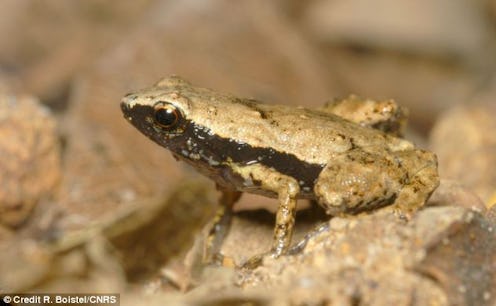News
This Tiny Frog Hears With Its Mouth

French Scientists revealed Monday how they believe the mysterious “earless” Gardiner’s frog can actually hear: by swallowing sound with its mouth.
Right.
One of the smallest frogs in the world, the dime-sized Gardiner’s frog is from the Seychelles islands, and apparently, it detects sound through the vibrations in its mouth. Previously, scientists were baffled as to why these petite amphibians appeared deaf, but spent their time croaking away. New research using detailed x-ray imaging has revealed that the frog’s mouths amplify and resonate sounds similar to the eardrum of other species. The findings were reported in the US journal the Proceedings of the National Academy of Sciences.
Led by Renaud Boistel from CNRS and the University of Poitiers, the scientists set up loudspeakers and played pre-recorded frog “songs” to the frogs in their natural rainforest habitat. Since the male Gardiner’s frogs responded with their own croaks, the scientists dug deeper, using Synchrotron x-ray imaging to demonstrate that the frogs transmit vibrations in their oral cavities through an extra-thin tissue layer to their inner ear. The frogs possess both thinner and fewer tissue layers between the mouth and inner ear than their ectothermic cousins.
“The combination of a mouth cavity and bone conduction allows Gardiner’s frogs to perceive sound effectively without use of a tympanic middle ear,” Dr. Boistel said.
Unlike most other frogs that use a middle ear with an eardrum situated on the surface of the head, Boistel believes these amphibians are a peek into evolution’s past — 47 to 65 million years in the past to be exact. Their isolation likely allowed them to keep an otherwise obsolete evolutionary trait.
Before the discovery, scientists had proposed a number of different sound-receiving mechanisms including: bone conduction, an extra-tympanic pathway through the lungs, or extra auditory pathways through the muscles connecting to the inner ear.
Nope, just its mouth.
Next up: scientists will attempt to solve the mystery of why frogs totally don’t get roads.
(Image: R. Boistel/CNRS)